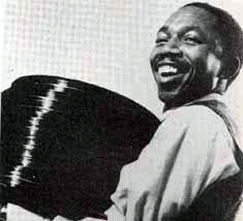Arts and culture
South African literature: the Drum decade
The Drum writers
The 1950s also saw a new generation of black writers talking about the conditions of their lives in their own voices - voices with a distinctive stamp and style. The popular Drum magazine in the 1950s was their forum, and encouraged their emergence. It depicted a vibrant urban black culture for the first time - a world of jazz, shebeens (illegal drinking dens), and flamboyant gangsters (tsotsis). These Drum writers, whose style will be later described by renowned writer Es’kia Mphahlele as "racy, agitated, impressionistic, it quivered with a nervous energy, a caustic wit", depicted urban deprivation, and also the resilience of people who survived "without visible means of subsistence". They recorded satirical stories ridiculing the discriminatory and repressive policies of the state, while others provided harrowing details of the effect of apartheid legislation on people’s lives. Their work ranged from the investigative journalism of Henry Nxumalo to the witty social commentary of Todd Matshikiza; others such as Nat Nakasa, Can Themba and Mphahlele moved toward embodying their visions of black South African life in poetry or fiction. Later, Nakasa edited a literary journal, The Classic, that published work such as Themba’s story "The Suit" (1963), now regarded as a classic of South African literature. Themba was banned by the apartheid state and died in 1968 in exile, but others such as Mphahlele pursued their literary careers. Lewis Nkosi became a noted literary critic in Europe and the United States. Other notable writers connected in some way to Drum include William Bloke Modisane, Arthur Maimane, Dyke Sentso, James Matthews, Peter Clarke, Richard Rive, Jordan Ngubane, Alex la Guma and Casey Motsisi. Modisane wrote the autobiography Blame Me on History (1963), Matthews has written much poetry and a novel, and Rive wrote Buckingham Palace, District Six (1986), about life in that coloured Cape Town area, and two novels about South African states of emergency, decades apart, Emergency (1964) and Emergency Continued (1989). The Drum Decade, edited by Michael Chapman, and A Good Looking Corpse, by Mike Nicol, anthologise and comment on key works of this era.Es'kia Mphahlele
Es’kia Mphahlele’s autobiographical Down Second Avenue (1959) is a landmark in the development of South African fiction. Set in a village and a township near Pretoria, the text records in evocative language the resilience of various female characters in Mphahlele’s life, women who defied poverty and urban squalor to bring him up. At the same time, they are presented with complexity and depth - his grandmother, for one, is a rather tyrannical figure. Mphahlele went on to write critiques The African Image (1962), short stories Man Must Live (1946), In Corner B (1967), as well as further novels, including The Wanderers (1971), in some ways an extension of the autobiographical form of Down Second Avenue. He also wrote poetry and autobiography. Taken as a whole, Mphahlele’s oeuvre represents one of the most important views of the life experience and developing views of a politically aware South African. In 2007, actor and theatre director James Ngcobo reworked Mphahlele’s poignant and emotional story "The Suitcase" into a highly successful play.The story continued ...
Would you like to use this article in your publication or on your website? See: Using SAinfo material

Todd Matshikiza: known for his witty social commentary


